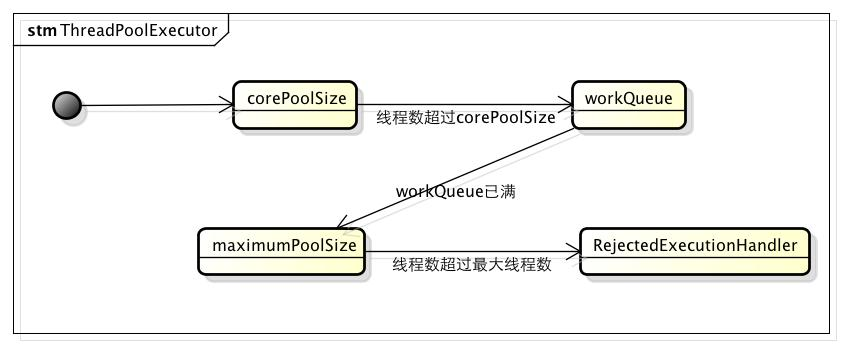一、概述
二、参数列表
| 参数名 | 作用 |
| corePoolSize | 核心线程池大小 |
| maximumPoolSize | 最大线程池大小 |
| keepAliveTime | 线程池中超过corePoolSize数目的空闲线程最大存活时间;可以allowCoreThreadTimeOut(true)使得核心线程有效时间 |
| TimeUnit | keepAliveTime时间单位 |
| workQueue | 阻塞任务队列 |
| threadFactory | 新建线程工厂 |
| RejectedExecutionHandler | 当提交任务数超过maxmumPoolSize+workQueue之和时,任务会交给RejectedExecutionHandler来处理 |
重点讲解:
其中比较容易让人误解的是:corePoolSize,maximumPoolSize,workQueue之间关系。
1.当线程池小于corePoolSize时,新提交任务将创建一个新线程执行任务,即使此时线程池中存在空闲线程。
2.当线程池达到corePoolSize时,新提交任务将被放入workQueue中,等待线程池中任务调度执行
3.当workQueue已满,且maximumPoolSize>corePoolSize时,新提交任务会创建新线程执行任务
4.当提交任务数超过maximumPoolSize时,新提交任务由RejectedExecutionHandler处理
5.当线程池中超过corePoolSize线程,空闲时间达到keepAliveTime时,关闭空闲线程(只会关闭超过corePoolSize的数)
6.当设置allowCoreThreadTimeOut(true)时,线程池中corePoolSize线程空闲时间达到keepAliveTime也将关闭
线程管理机制图示:

三、Executors配置方案
1、构造一个固定线程数目的线程池,配置的corePoolSize与maximumPoolSize大小相同,同时使用了一个无界LinkedBlockingQueue存放阻塞任务,因此多余的任务将存在再阻塞队列,不会由RejectedExecutionHandler处理。
public static ExecutorService newFixedThreadPool(int nThreads) {
return new ThreadPoolExecutor(nThreads, nThreads,
0L, TimeUnit.MILLISECONDS,
new LinkedBlockingQueue<Runnable>());
} 2、构造一个缓冲功能的线程池,配置corePoolSize=0,maximumPoolSize=Integer.MAX_VALUE,keepAliveTime=60s,以及一个无容量的阻塞队列 SynchronousQueue,因此任务提交之后,将会创建新的线程执行;线程空闲超过60s将会销毁。
public static ExecutorService newCachedThreadPool() {
return new ThreadPoolExecutor(0, Integer.MAX_VALUE,
60L, TimeUnit.SECONDS,
new SynchronousQueue<Runnable>());
}
3、构造一个只支持一个线程的线程池,配置corePoolSize=maximumPoolSize=1,无界阻塞队列LinkedBlockingQueue;保证任务由一个线程串行执行。
public static ExecutorService newSingleThreadExecutor() {
return new FinalizableDelegatedExecutorService
(new ThreadPoolExecutor(1, 1,
0L, TimeUnit.MILLISECONDS,
new LinkedBlockingQueue<Runnable>()));
} 4、 构造有定时功能的线程池,配置corePoolSize,无界延迟阻塞队列DelayedWorkQueue;有意思的是:maximumPoolSize=Integer.MAX_VALUE,由于DelayedWorkQueue是无界队列,所以这个值是没有意义的。
public static ScheduledExecutorService newScheduledThreadPool(int corePoolSize) {
return new ScheduledThreadPoolExecutor(corePoolSize);
}
public static ScheduledExecutorService newScheduledThreadPool(
int corePoolSize, ThreadFactory threadFactory) {
return new ScheduledThreadPoolExecutor(corePoolSize, threadFactory);
}
public ScheduledThreadPoolExecutor(int corePoolSize,
ThreadFactory threadFactory) {
super(corePoolSize, Integer.MAX_VALUE, 0, TimeUnit.NANOSECONDS,
new DelayedWorkQueue(), threadFactory);
} 四、定制自己的线程池
public class ThreadPoolManager {
private static final Logger logger = LoggerFactory.getLogger(ThreadPoolManager.class);
private static ThreadPoolExecutor threadpool =
new ThreadPoolExecutor(10, 100, 30, TimeUnit.SECONDS, new ArrayBlockingQueue(50),new MessageThreadFactory(),new MessageRejectedExecutionHandler());
// 是指线程池一启动的时候,就会直接创建核心数线程10个,然后当再有任务进来的时候,在入队到阻塞队列里,如果
// 队列数超过50个了,才会开始继续创建额外的线程,直到达到最大线程数100个
static class MessageThreadFactory implements ThreadFactory {
private AtomicInteger count = new AtomicInteger(0);
@Override
public Thread newThread(Runnable r) {
Thread t = new Thread(r);
String threadName = ThreadPoolManager.class.getSimpleName() + count.addAndGet(1);
logger.debug("新建线程:"+logger);
t.setName(threadName);
return t;
}
}
static class MessageRejectedExecutionHandler implements RejectedExecutionHandler {
@Override
public void rejectedExecution(Runnable r, ThreadPoolExecutor executor) {
try {
executor.getQueue().put(r); // 加了这句,则就是阻塞线程池了
} catch (InterruptedException e) {
e.printStackTrace();
}
}
}
public static void submit(Runnable task){
threadpool.submit(task);
}
public static Future<String> submit(Callable<String> task){
return threadpool.submit(task);
}
}






 本文详细解析了Java线程池的参数配置与工作原理,包括核心线程池大小、最大线程池大小、任务队列等关键概念,并介绍了四种常用的线程池创建方式。
本文详细解析了Java线程池的参数配置与工作原理,包括核心线程池大小、最大线程池大小、任务队列等关键概念,并介绍了四种常用的线程池创建方式。

















 170万+
170万+

 被折叠的 条评论
为什么被折叠?
被折叠的 条评论
为什么被折叠?








